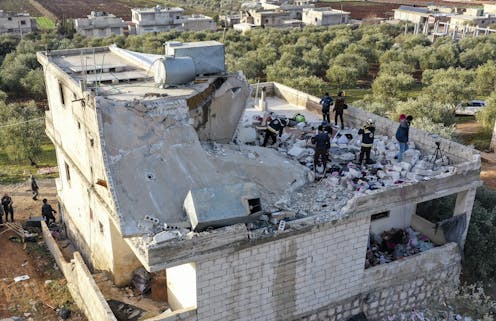Islamic State leader killed in US raid – where does this leave the terrorist group?
- Written by Haroro J. Ingram, Senior Research Fellow at the Program on Extremism, George Washington University

An overnight raid conducted by U.S. special forces in Syria has resulted in the death of the leader of the terrorist Islamic State group[1].
Abu Ibrahim al-Hashimi al-Qurayshi was killed as he exploded a bomb at his compound in the country’s northwestern Idlib province. The blast also caused the death of members of his family, including children, U.S. officials said[2].
This isn’t the first time that American forces have targeted the head of terrorist organizations, nor the first time they have been successful. The Conversation asked Amira Jadoon[3], a terrorism expert at the U.S. Military Academy, and Haroro J. Ingram[4] and Andrew Mines[5], research fellows at the George Washington University’s Program on Extremism, to explain how this raid fits the U.S.‘s counterterrorism strategy, and where it leaves the Islamic State.
1. Who was Abu Ibrahim al-Hashimi al-Qurayshi?
Abu Ibrahim al-Hashimi al-Qurayshi is the alias adopted[6] by Amir Muhammad Sa’id Abdal-Rahman al-Mawla, who became leader of the Islamic State in 2019 following the death of Abu Bakr al-Baghdadi in a U.S. raid[7].
He was born in 1976 in Mosul, northern Iraq. But very little was known about al-Qurayshi until September 2020, when it emerged that he had been detained and interrogated by U.S. forces in Iraq in early 2008.
Declassified tactical interrogation reports[8] from that period depict al-Qurayshi[9] as a recently graduated scholar who experienced a meteoric rise through the Islamic State group’s ranks.
Al-Qurayshi claimed that he joined[10] the group in 2007, having finished a master’s degree in Quranic studies from Mosul University.
Soon after joining, al-Qurayshi became the group’s Shariah adviser, a major religious figure, in Mosul and later the deputy “wali,” or shadow governor, of the city before his capture in early 2008.
The interrogation reports show that al-Qurayshi revealed the names of at least 20 alleged members of the Islamic State of Iraq, as the group was known at the time. His betrayal[11] came at a time when group members were being killed or captured in large numbers by U.S. and coalition forces.
Relatively little is known about al-Qurayshi’s activities for the next decade after he was released. But he reportedly oversaw the Islamic State group’s attempted genocide[12] of Iraq’s minority Yazidis and had served as deputy to al-Baghdadi[13] since at least 2018.
His rise to “caliph” was controversial in jihadist circles[14], not helped by the release of his interrogation records after becoming leader.
2. Where does his death leave Islamic State operationally?
The operation against al-Qurayshi arrives at a precarious time for the Islamic State group. The organization’s transition[15] from an Iraq-centric movement to a global insurgency with affiliates[16] dotted across the Middle East, Africa, and Asia is still relatively fresh.
Recent Islamic State attacks on Hasakah prison[18] in northeast Syria and elsewhere across Iraq[19] have hinted that the group is more advanced in rebuilding its capabilities across traditional heartlands than perhaps expected. But the death of al-Qurayshi just two years after that of his predecessor raises uncertainty over who will succeed him.
The fact that the Islamic State group couldn’t protect its top leader shows the continued pressure the group faces from U.S. and allied forces.
Al-Qurayshi’s rapid demise – his predecessor led for almost a decade – may also indicate internal rifts. After he took over as leader, al-Qurayshi was mockingly described by dissenters within the terrorist group[20] as “an unknown nobody” while others questioned his suitability as leader[21], especially after the release of his interrogation reports in September 2020.
It may be that al-Qurayshi was himself betrayed, ultimately contributing to the circumstances that led to the U.S. raid. If so, it could indicate a split within the group between al-Qurayshi and those who wanted him gone.
Now, the Islamic State is likely to appoint al-Qurayshi’s successor[22] based on the deliberation of its shura council, its senior leadership panel, as it has done previously.
If it happens as it has in the past, al-Qurayshi’s successor could be appointed in the next few days or weeks. He’ll be given an alias to conceal his identity. Group members and leaders of Islamic State global affiliates will be asked to pledge allegiance to him, but he may not make a public appearance for months or years – if ever.
3. What effect has killing the heads of terrorist groups had in the past?
Leadership decapitation[23] – or the targeted killing of militant groups’ top leaders – is a key component of counterterrorism and counterinsurgency. It is widely used by many nations, including the United States[24].
But terrorism experts don’t agree on how effective killing top leaders is. Some have argued that taking out a terrorist leader constrains[25] the operational capacity of groups and disrupts their organizational routines, making it harder for them to carry out attacks.
It may, it has been argued, also contribute to organizational collapse[26]. Research shows that under the right circumstances, the targeting of top leaders can result in fewer violent attacks[27] by a militant group and increase the chances of defeating an insurgency.
Yet other counterterrorism experts highlight problems with targeted killings. They argue that they can result in decentralization of the group[28] and increase indiscriminate violence[29] by targeted groups.
The tactic is also generally considered to be less effective against groups like the Islamic State and al-Qaida that have well-managed leadership structures and succession protocols[30].
The Islamic State group has survived multiple deaths within its leadership precisely because of its bureaucratic approach to succession, and because it still enjoys pockets of strong local support.
In the short term, the death of al-Qurayshi may cause the Islamic State group to lie low. But this will not indicate the demise of the organization. The loss of al-Qurayshi could also trigger retaliation attacks as a signal of resolve among members and to stay relevant in the global jihadist landscape.
4. How much of a global and regional threat is Islamic State group?
Back in early 2019, the U.S. and allied forces successfully beat back[31] the Islamic State group from its height in 2014-16, when it controlled larges parts of Iraq and Syria.
The group has recently shifted attention[32] to prominent affiliates, like those in sub-Saharan Africa and Afghanistan.
This shift highlights how[33] the Islamic State has maintained its relevance: If it experiences decline in its strongholds of Iraq and Syria, affiliates elsewhere are able to keep the vision of the global caliphate alive.
The recent terrorist attacks in Syria[34] and Iraq[35] suggest that the Islamic State’s resurgence strategy is much further along than many observers may have expected.
Elsewhere, affiliates are engaged in intense insurgencies against local governments and rival militant groups. This includes persistent threats from IS-West Africa Province[36] in the Lake Chad region, and IS-Central Africa Province[37] in the Congo and Mozambique. Indeed, Africa is poised to be a key Islamic State battleground[38] going forward.
Meanwhile in Afghanistan, ISIS-K has pursued a relatively successful strategy[39] to rally after years of losses at the hands of the U.S.-led coalition[40], challenging the new Taliban government and competing for control of provinces in the country’s northeast.
The death of al-Qurayshi is unlikely to affect the operations of Islamic State group’s affiliates in any meaningful way. Many have strategies that draw heavily on local resources and alliances with other groups. While the latest U.S. raid may result in temporary uncertainty for the broader movement, history suggests the Islamic State movement will be able to push forward with regional attacks and reestablish the support of affiliates around the world.
[Like what you’ve read? Want more? Sign up for The Conversation’s daily newsletter[41].]
References
- ^ death of the leader of the terrorist Islamic State group (www.reuters.com)
- ^ U.S. officials said (www.reuters.com)
- ^ Amira Jadoon (www.westpoint.edu)
- ^ Haroro J. Ingram (extremism.gwu.edu)
- ^ Andrew Mines (extremism.gwu.edu)
- ^ the alias adopted (www.nytimes.com)
- ^ death of Abu Bakr al-Baghdadi in a U.S. raid (www.bbc.com)
- ^ tactical interrogation reports (ctc.usma.edu)
- ^ depict al-Qurayshi (ctc.usma.edu)
- ^ claimed that he joined (ctc.usma.edu)
- ^ His betrayal (foreignpolicy.com)
- ^ oversaw the Islamic State group’s attempted genocide (edition.cnn.com)
- ^ served as deputy to al-Baghdadi (www.aymennjawad.org)
- ^ controversial in jihadist circles (www.jihadica.com)
- ^ organization’s transition (www.hudson.org)
- ^ global insurgency with affiliates (theconversation.com)
- ^ AP Photo/Ghaith Alsayed (newsroom.ap.org)
- ^ attacks on Hasakah prison (www.washingtonpost.com)
- ^ across Iraq (www.nbcnews.com)
- ^ dissenters within the terrorist group (www.jihadica.com)
- ^ questioned his suitability as leader (warontherocks.com)
- ^ appoint al-Qurayshi’s successor (www.jihadica.com)
- ^ Leadership decapitation (www.jstor.org)
- ^ including the United States (www.sup.org)
- ^ taking out a terrorist leader constrains (www.foreignaffairs.com)
- ^ contribute to organizational collapse (cup.columbia.edu)
- ^ fewer violent attacks (www.belfercenter.org)
- ^ decentralization of the group (doi.org)
- ^ increase indiscriminate violence (doi.org)
- ^ have well-managed leadership structures and succession protocols (doi.org)
- ^ successfully beat back (www.bbc.com)
- ^ recently shifted attention (ctc.usma.edu)
- ^ highlights how (www.hudson.org)
- ^ Syria (www.washingtonpost.com)
- ^ Iraq (www.nbcnews.com)
- ^ IS-West Africa Province (institute.global)
- ^ IS-Central Africa Province (extremism.gwu.edu)
- ^ Islamic State battleground (www.hurstpublishers.com)
- ^ relatively successful strategy (ctc.usma.edu)
- ^ losses at the hands of the U.S.-led coalition (ctc.usma.edu)
- ^ Sign up for The Conversation’s daily newsletter (memberservices.theconversation.com)
Authors: Haroro J. Ingram, Senior Research Fellow at the Program on Extremism, George Washington University





